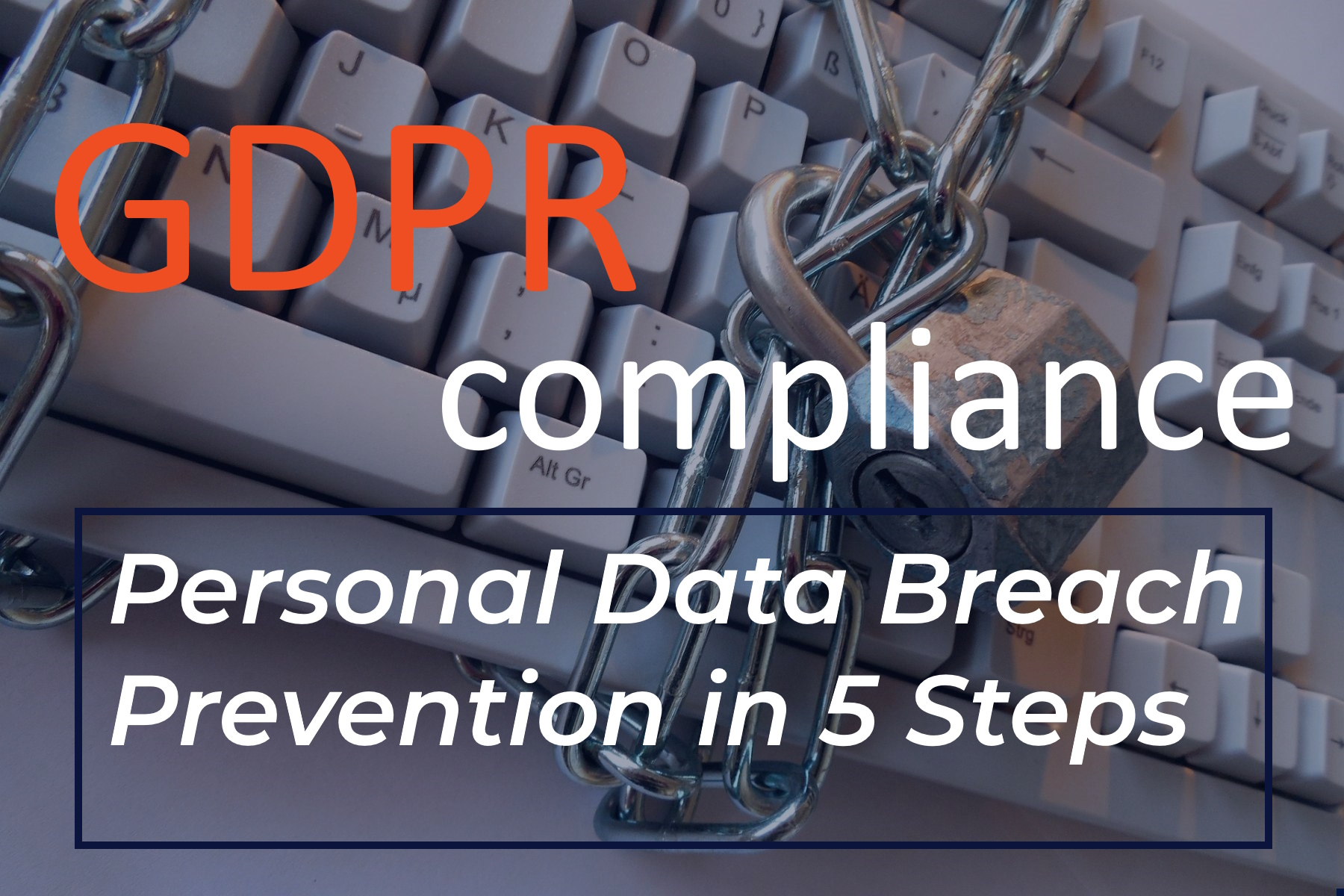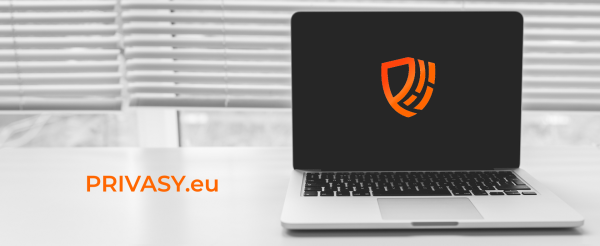Prevention of Personal Data Breaches in 5 Steps
Personal Data Breaches
According to article 4(12) of the GDPR, a 'personal data breach means a breach of security leading to the accidental or unlawful destruction, loss, alteration, unauthorised disclosure of, or access to, personal data transmitted, stored or otherwise processed', in other words, an incident in which personal data is exposed or otherwise made available to unauthorized persons. This could be due to hacking, theft, or other malicious activities, as well as unintentional human errors. It could also be caused by a lack of adequate security measures, including encryption and other safeguards.
Despite the potential harm, many organizations still don't have a good understanding of the risks associated with personal data breaches. The consequences of a personal data breach can be far-reaching and have a significant impact on an organization's reputation, financial stability, and legal obligations. In this article, we outline the five key steps organizations should take to prevent personal data breaches:
1. Create a comprehensive security policy
Creating a comprehensive security policy for an organization is essential for protecting customer personal data. Encryption is a key measure to ensure customer data is secure from unauthorized access. Access controls should be implemented to restrict access to customer data to only those with the necessary permissions. This will protect customer data from being accessed by unauthorized personnel and will help maintain the integrity of the data. Data backup is also important for safeguarding customer data in the event of a system failure or data loss. Backups should be performed at least once a day and stored in a secure offsite location.
In addition to these measures, organizations should also consider implementing security measures such as two-factor authentication, regular security audits, and robust user training. Two-factor authentication can provide an extra layer of security by requiring users to enter a code sent to their mobile phone or email address in order to access customer data. Regular security audits can help identify any potential security vulnerabilities and help to ensure any identified issues are addressed in a timely manner. Finally, organizations should provide robust user training to ensure employees are familiar with the security policy and understand the importance of protecting customer data.
To illustrate, consider a small retail business that holds sensitive customer data. They should develop a comprehensive security policy that includes encryption, access controls, and data backup. They should also consider implementing two-factor authentication, regular security audits, and user training. By doing so, they can ensure their customer data is secure and protected from unauthorized access.
2. Train employees on security protocols
Organizations must ensure their employees are well-trained and up-to-date on security protocols. This training should be tailored to the organization's specific security policy and should cover best practices for handling customer data. For example, employees should be trained to never send customer information over unsecured networks or share it with unauthorized individuals. Establishing a secure data environment is essential for protecting customer data and creating a safe working environment.
To illustrate, if an employee is emailing customer information to a vendor, they should ensure the email is being sent over a secure network. Additionally, they should check that the recipient of the email is authorized to receive the customer data. If an employee is using an external storage device to store customer data, they should be aware of the risks of using external storage and should be trained on the proper security protocols to ensure the data is safe. Furthermore, if an employee is using a public Wi-Fi, they should use a Virtual Private Network (VPN) to ensure the data is encrypted and secure.
Overall, providing training on security protocols is essential for protecting customer data and creating a secure working environment. By following the security protocols outlined in the security policy and best practices for handling customer data, organizations can ensure their employees are taking the necessary precautions to protect customer data and maintain a secure environment.
3. Monitor access to data
Organizations should take measures to ensure the security of their customers' data by monitoring access to it. This should begin with requiring employees to use two-factor authentication when accessing customer information. This will add an extra layer of security to the data and make it more difficult for malicious actors to gain access. Additionally, organizations should keep track of who has access to customer data and who has made changes to it. This will make it easier to identify any suspicious activity, such as unauthorized access or changes to the data.
For example, if an organization requires two-factor authentication for employees to access customer data, they can be sure that only authorized personnel have access to the information. If a suspicious login attempt is detected, the organization can investigate and take action to prevent further attempts. Additionally, if any changes are made to the customer data, the organization can track who made the changes and take steps to ensure the data remains secure.
Finally, organizations should take steps to ensure that customer data is not shared with any third parties without the customer's consent. This includes making sure that customer data is not being used for any purpose other than what was intended. By taking steps to monitor access to customer data, organizations can ensure that the data remains secure and that customers are protected from any unauthorized access or use.
4. Implement data breach response plans
Data breaches can cause catastrophic damage to an organization’s reputation, customer base, and even bottom line. Having a data breach response plan in place is a necessary step for any organization to take to protect itself in the event of a breach. The plan should provide a clear set of steps for how the organization will respond, including how it will notify customers and the public, measures it will take to protect customer data, steps it will take to investigate the breach, and how it will prevent similar breaches from occurring in the future.
For example, if a web hosting company experiences a breach, its response plan could include steps to notify customers, immediately shut down the affected servers, investigate how the breach occurred, and implement new security measures to prevent similar breaches in the future. After notifying customers, the company may offer them free identity theft protection or other services to mitigate the risks of their personal data being exposed. The company may also offer customers the opportunity to opt out of any services that involve the storage of their data until new security measures have been put in place.
Having a data breach response plan in place is essential for any organization. It helps organizations respond quickly and efficiently in the event of a breach, while also protecting customer data and maintaining customer trust. In the end, having a plan can help an organization get back on its feet more quickly and with minimal long-term damage.
5. Update security measures regularly
Security measures are an important component of any organization's overall risk management strategy. Regularly updating security measures helps ensure that systems, networks, and data remain secure. This includes updating software and hardware to ensure they are running the latest versions and patching any known vulnerabilities. Additionally, organizations should regularly test security protocols, such as authentication and encryption, to ensure they are up to date.
For example, let's say an organization has an authentication system that requires users to enter a username and password. To ensure the security of user accounts, the organization should regularly update the authentication system and test it to ensure it is working properly and up to date. If the organization finds a vulnerability in the system, they should immediately patch it and update their security protocols accordingly. Additionally, if the organization finds that the authentication system is no longer effective, they should look into upgrading to a more secure system.
In another example, an organization may have an outdated software or hardware system that is vulnerable to attack. The organization should regularly assess their system and update any outdated software or hardware to ensure that the system is secure from outside threats. Additionally, the organization should regularly test the security protocols of the system and update any vulnerabilities that may be found.
By regularly updating security measures and testing security protocols, organizations can ensure that their systems, networks, and data remain secure. Additionally, they can stay ahead of potential threats and prevent any security breaches. Regularly updating security measures is critical to an organization's overall risk management strategy.
By taking these steps, organizations can significantly reduce their risk of personal data breaches. Organizations should also review their security measures regularly to ensure they remain up to date and remain vigilant in protecting their customers' data. Doing so can help protect customers' data and reduce the risk of a data breach. Preventing data breaches is a complex process that requires commitment and knowledge from all people within the organization. 22Academy can be a valuable partner in this process, providing GDPR awareness and complete training courses to help prepare for the CIPP/E exam. The 'CIPP/E Focus Course - security and accountability' is especially helpful in helping organizations to protect personal data and prevent data breaches. With the right training and support, organizations and their employees, can be sure they have the knowledge and tools to protect their personal data from breaches, and just as important, know what to do if the inevitable personal data breach occurs.



